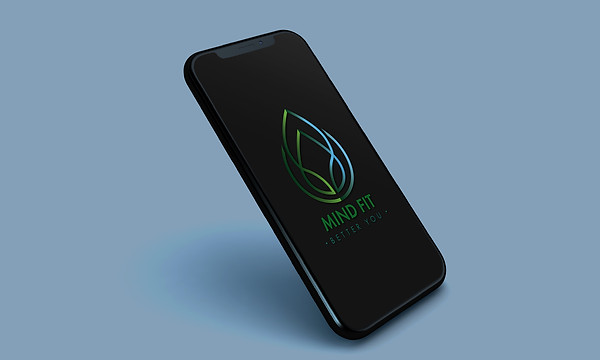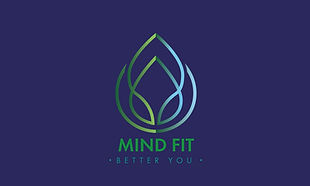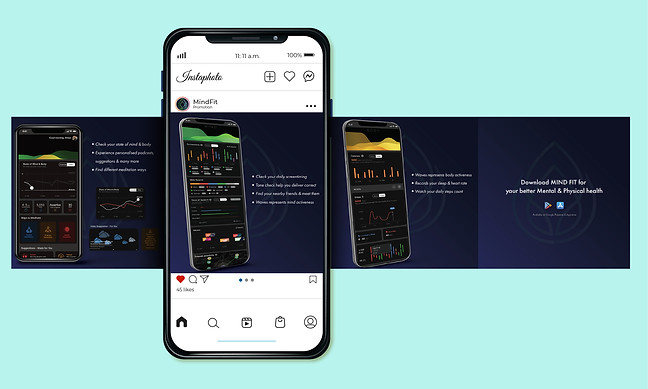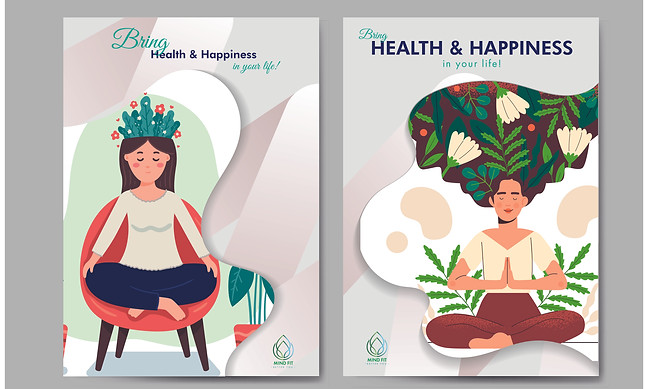

Mind Fit
Empowering minds, one click at a time. MindFit is a thoughtfully crafted mental wellness app designed to prioritize mindfulness and emotional balance. With a soothing interface, user-first design, and intuitive features, this project reflects the harmony of tech and self-care.

Understanding the Problem
A societal need or social context background
1 in 5 U.S. adults experiences mental illness. 2017 study estimates that 792 million people lived with a mental health disorder. This is slightly more than one in ten people globally. Early signs of mental illness such as anxiety, depression, and loneliness can be preventable if diagnosed early.
Research
Market Analysis:
-
Various applications users are relatively new to mental health care, the usages are increasing phenomenally and It is difficult to predict the trustworthiness of these apps by looking at their rating and the number of people who rated.
-
There is no single guide for the development of evidence-based Mental health apps. Many of the apps lack features to improve their functionality or include features that are not optimized to improve mental health.
-
A systematic review revealed a complete lack of trial-based evidence for many of the mental health applications available.
-
The majority of the mental health apps are made simple and involve less complex interactive methods.
-
Multiple meta-analyses on apps focusing on multiple mental health problems show very different results at times.
Disadvantages of other Applications:
-
Countless self-tracking apps require the user to wear a wearable or need active participation to track themselves.
-
There are hundreds of mental health apps, but it is estimated that only about 3% to 4% are actually evidence-based.
-
A systematic review revealed a complete lack of trial-based evidence for many of the mental health applications available.
-
There is no single platform available to track all the activities that the user is performing.
-
There is no definite outcome defined from self-tracking.
User Persona


Depression
Symptoms:
-
Depression can get vocalized as, “It’s my fault”, “What’s the point?” - Tone of Speech/Text/Email
-
Disturbed sleep: Sleep cycle monitoring
-
Avoiding contact with friends and taking part in fewer social activities –Social proximity monitoring, Increase in screen time.
-
Neglecting your hobbies and interests – Increase in screen time.
Anxiety
Symptoms:
-
Having a hard time concentrating: Toggling between the apps with less time required to recognize the content.
-
Feeling tired: Reduction in the speed of activities generally tracked.
-
Irritability: Tone of speech/Texts/Emails
-
Rapid Heartbeat: This can be measured by changes in blood volume below the skin’s surface, known as, Photoplethysmography.
-
Feeling shaky: This can be measured with the help of an accelerometer.
Concept Execution
Most of us use various apps and IoT that collect various data. Yet a lot of value lies in connecting these apps and their data to help use self track (quantified self). It's humanto want to get better at what to do, not just at work but in life. Smartphones are gateways digital realm and we speculate data smartphone users generate are far more powerful than anticipated.
Our platform synchronize/harvest data across different apps, and aims to help smartphone users identify and flag early signs of increasing stress, anxiety, depression etc. and provide insight into what's driving those changes and promote a healthy mind & body.
Sketches
This was the first step to help with outlining and visualizing the app.


Flow Chart

High Fidelity Wireframes
This visual guide represents the framework of the app. It helped me arrange the interface elements while I focused on the functionality rather than appearance. I based it on the user information from users.





Color Palette
The color palette for a psychology-related application must be pleasant, trustworthy, fresh, clean, and readable. Therefore, I decided to use a light color palette, with the typography in contrasting colors. The application needs to tell a story to the user.

Final Frames
Flash Screen

Onboarding Screens





Home Screen
Mind-Fit assigns a generative art (waveform) to the user, after analyzing the data received through smartphone usage and physical activity, proximity with other human beings, and interactions with them.
State of Mind & Body:
Mind-Fit generated a mood board as per the user's activity and behavior. The board gives the user a chance to compare today's mood with a previous mood board. The Waves will harvest the data from the user's daily activities in both the mind and body sections. The synchronized data from different areas will help the waves to move from left to right. The movement of waves is divided into 3 categories gloomy, neutral, and cheerful. If the user activities are much less, the waves will move very slowly, which means the user is not spending the required amount of time, and the bar graph will go down to Gloomy. The higher the activities the faster the waves will move from gloomy to cheerful. The average amount of activities is supposed to be on a neutral bar.
The home page shows two different colored waves which are a combination of both mind and body. In which yellow color indicates for body and green at the back indicates for mind section.
The movement of waves is divided into 3 categories gloomy, neutral, and cheerful. If the user activities are very less in an amount the waves will move very slowly, which means the user is not spending the required amount of time, and the bar graph will go down to Gloomy. The higher the activities the faster the waves will move from gloomy to cheerful. The average amount of activities is supposed to be on a neutral bar.
Mind Screen
MindFit analyzes your screen time, web search, tone of speech, music, friends proximity, and other online activities and It categorizes your mind into 3 states, Calm, Neutral, and Hyper. and provides personalized evidence-based information.
The Tone of speech picks up on the pitch, intensity, and tempo of your voice and then categorizes them into notable moments that you can go back and review throughout the day.
Friend's proximity displays what genres of music you listened to and what time of the day and shows its impact on your mind.
Body Screen
Tracking physical activities:
MindFit tracks the user’s physical activities during the entire day and gives feedback on the basis of their daily activities.
The user is given information about the history of their activities and a comparison between their past and present physical activities.
Community
Mind fit has made some of the predefined community groups where users can communicate in rooms that accommodate groups of thousands of people. The user can easily access the group and talk about their mental health or the other problems they are suffering. This will help the user to find better solutions to their problems which they are not able to express socially.
Mind Fit Branding
VIsiting Card


-01.jpg)
-02.jpg)
Instagram Page

Mind Fit Poster


